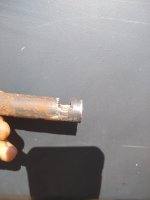Mnethercutt
Member
Folks,
Put the head back on my (newish to me) 48 B today. When I purchased it, previous owner didn't know when it last ran, and as would be expected it had a few stuck valves. Took the head off, unstuck the valves, did a valve grind, and put everything back together. Today I got out, installed the new head gasket and bolted the head on. I started to fill the radiator with water for the tractors first test run in probably 15+ years and I heard a bubbling sound. At first I thought it was just air getting out of the system, but boy was I wrong when about 10 seconds later water started running out of the belt pulley.
Somehow I've got more than a 2 quarts per minute of water flowing directly from the cooling system into the crankcase. What in the world did I do wrong?
Some things to consider:
-All 4 studs for the manifold snapped off so I drilled out the holes, tapped them, and am now using grade 5 bolts instead of studs (which I put sealant on the end of to prevent leaks)
-I used a new head gasket kit which came with copper washers. I soaked the gasket in oil, placed it on the studs, then put the head on, then the washers and nuts. Are there any washers that are supposed to go between the head and the block? From my reading in the service manual and several YouTube videos I feel like I installed the head and new gasket correctly.
-Head is B2501R. I visually inspected the 2 pushrod sleeves but didn't see anything wrong with them.
Any thoughts? I understand with a tractor that sat for 15 years there could be cracks or pinholes, but the fact that its literally pouring water into the crankcase as fast as I can fill the radiator makes me think either I really screwed up something on install or there's a part missing somewhere. What are my options for troubleshooting?
Thanks!
Put the head back on my (newish to me) 48 B today. When I purchased it, previous owner didn't know when it last ran, and as would be expected it had a few stuck valves. Took the head off, unstuck the valves, did a valve grind, and put everything back together. Today I got out, installed the new head gasket and bolted the head on. I started to fill the radiator with water for the tractors first test run in probably 15+ years and I heard a bubbling sound. At first I thought it was just air getting out of the system, but boy was I wrong when about 10 seconds later water started running out of the belt pulley.
Somehow I've got more than a 2 quarts per minute of water flowing directly from the cooling system into the crankcase. What in the world did I do wrong?
Some things to consider:
-All 4 studs for the manifold snapped off so I drilled out the holes, tapped them, and am now using grade 5 bolts instead of studs (which I put sealant on the end of to prevent leaks)
-I used a new head gasket kit which came with copper washers. I soaked the gasket in oil, placed it on the studs, then put the head on, then the washers and nuts. Are there any washers that are supposed to go between the head and the block? From my reading in the service manual and several YouTube videos I feel like I installed the head and new gasket correctly.
-Head is B2501R. I visually inspected the 2 pushrod sleeves but didn't see anything wrong with them.
Any thoughts? I understand with a tractor that sat for 15 years there could be cracks or pinholes, but the fact that its literally pouring water into the crankcase as fast as I can fill the radiator makes me think either I really screwed up something on install or there's a part missing somewhere. What are my options for troubleshooting?
Thanks!


